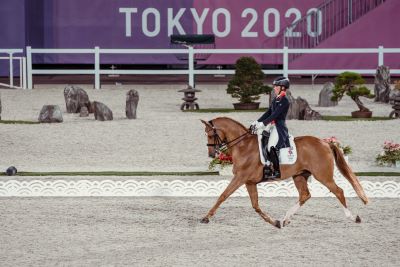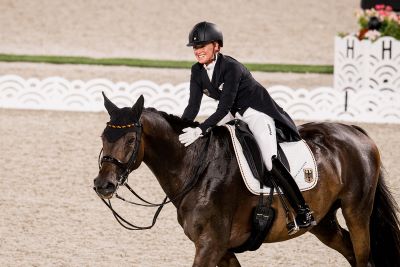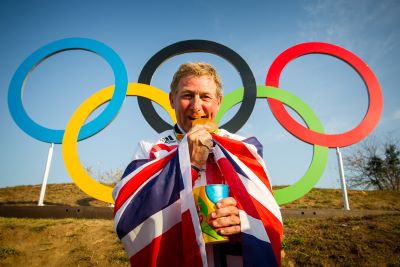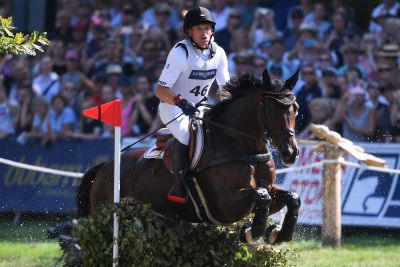Germany’s Dorothee Schneider, Isabell Werth, and Jessica von Bredow-Werndl celebrating Dressage team gold. (FEI/Shannon Brinkman)
Victory for Germany in the Dressage team event at the Tokyo 2020 Olympic Games will go down in the history books. For the last 27 years the country that has long been the cradle of classical horsemanship has been all but unbeatable at this level of the sport, and despite the disruption and confusion of the last 18 months right across the globe they reigned supreme once again ahead of Team USA in silver and Great Britain in bronze.
There were mixed reviews for the new team format which separates athletes into groups and reduces team numbers to three, with all scores to count. But there was no denying the increased intensity and excitement it created in this deciding Grand Prix Special. While the Germans came out clear champions, the battle for silver and bronze was a thriller to the very end.
And a new star was born. Germany’s Jessica von Bredow-Werndl stole the show with the new Olympic Grand Prix Special score of 84.666 with the mare Dalera, and team-mate Isabell Werth posted 83.298 with a beautiful performance from her beloved Bella Rose after Dorothee Schneider and Showtime set out the German stall when putting 80.086 on the board. However, a relatively unknown American produced the third-best score of that decided the fate of the team medals. Sabine Schut-Kery and Sancero have rocketed onto the world stage.
Set for silver
Great Britain looked set for silver in the early stages after Carl Hester and En Vogue posted 78.344, while it seemed Denmark and the USA were locked into a game of cat-and-mouse for the bronze. But the Americans couldn’t have been more rock solid, Adrienne Lyle’s 76.109 with Salvino giving them a firm basis on which to build before Steffen Peters and Sussenkasper backed that up with 77.766.
Cathrine Dufour and Bohemian were the last pair to go for Denmark, but 77.720 wouldn’t be enough to keep her country in the race, especially when America’s Schut-Kery followed with an incredible 81.596. That just knocked the Danes right out of contention and suddenly the British were under threat for their silver medal spot too. It would take a big score from Charlotte Dujardin and Gio to keep Britain out in front after Lottie Fry’s 76.894 with Everdale.
And although Dujardin’s inexperienced chestnut gelding did his best, his 79.544 just wouldn’t be enough.
Meanwhile, last to go von Bredow-Werndl strutted to a score of 84.666 to put the icing on the German cake. And that was despite a whoopsie in the one-tempis when her mare needed a toilet break. As von Bredow-Werndl said afterwards, it was just another day at the office for the lovely, talented Dalera. “It didn’t feel difficult actually; for her it all seems to be easy!”
Dominant
Werth was asked about her expectations coming to Tokyo in light of the long and dominant German record at Olympic Games. “We are long enough in this sport to know that one horse can make a difference, and one situation can make a difference, especially when you are only three on a team and you have no reserve. We came with a lot of self-confidence because we knew if we bring our performance in the arena like we can then it would be really hard to beat us, but you never know. One bad day or a sick horse or after such a long trip everything is possible,” she replied.
That’s one more gold medal for the German superwoman who, as former Eventing star/turned commentator Lucinda Green pointed out on Sunday night, is wearing riding boots that been around a while and seen a lot of action.
“I’ve had them since 1991 and I’ve worn them at every Championship since then – they are my lucky boots!” the German superstar admitted. That’s 30 years of service, with many golden moments along the way, and Lady Luckyboots may well be about to make more history.
This brought her Olympic gold medal tally to seven, and if Werth can add one more in the much-anticipated Freestyle for the Individual title, then she will match the German record set by rower Birgit Fischer, who has won 8 gold and 4 silver Olympic medals during her sparkling career.
Facts and Figures:
Germany first won team gold at the Olympic Games in Amsterdam (NED) in 1928, with a three-man team of Carl Freiherr von Langen (Draufganger), Hermann Linkenbach (Gimpel), and Eugen Freiherr von Lotzbeck (Caracalla).
Germany were the defending champions coming to the Tokyo 2020 Olympic Games and two of the winning team members were in the side that reigned supreme at the Rio 2016 Games -. Dorothee Schneider riding the same horse, and Showtime and Isabell Werth riding her other great mare Weihegold.
Quotes:
Isabell Werth (GER) – “I expected higher scores, but it is like it is. She (Bella Rose) was more tense on the first day, already in good shape but more tense and I had to deal a bit with her temperament. That’s on one hand her advantage; she’s 17 but also you could say she is 12. She wants to go and sometimes her temperament needs time to cope with the situation and the atmosphere. Today she was so relaxed and super.
I love this horse and I hope she loves me too. She is a gift!”
Charlotte Dujardin (GBR) – ‘I went in there to do best I could and I’m absolutely thrilled with Pumpkin (Gio), because that’s the second time he’s gone through that Grand Prix Special; we’ve had very little shows to compete in this year; he is only 10 years old and with not a lot of experience at all and the last few days he’s really tried his heart out, and I can’t really ask for more than that. This might look like bronze but for me and my horse it feels like a gold medal.”
Carl Hester (GBR) – “The feeling I had before we came here was that it was going to be a very different and very difficult Olympics and wasn’t going to be any fun, but it’s been an amazing experience…. Charlotte and I work together; the horses have brought up at home from an early age and we are excited about them. We’ll see how they travel back home and where we’ll go next. There’s a Europeans (Championship) in six weeks so we’ll see how they are when we get back and go from there.”
Steffen Peters (USA), after completing his test with Sussenkasper: “I’m more than delighted. I did exactly what I wanted for my team; it’s one thing to ride individually but when you pull a good score for your team it’s really special. I cried when I came out, gave Mopsie a big hug, and just thanked him from the bottom of my heart. He did it for me when it really counted. It’s an incredible feeling when an animal fights for you like that.”
Carl Hester (GBR), talking about his ride on En Vogue – “It was cool. He is very nervous and I’ve struggled with his nerves… if I ride him too forward, he’s too tense and if I don’t give enough, he makes a lot of mistakes. It’s the old cliché: he came here as a boy and he’s gone in there like a man tonight! He’s done everything I asked.”
Adrienne Lyle (USA), talking about her ride on Salvino – “I’m super-thrilled. I was really hoping we could pull that score off for the team today; we were a little conservative in the Grand Prix; it wasn’t our most great display so I really wanted to come out here and push for a bit more, and despite the heat and humidity he was a really good boy; he delivered – no mistakes which is what you want for the team test, and now it’s up to the other team-mates to go out there and be just as strong!
I’ve been riding him for six years; he’s the most amazing horse; we’ve been to a World Games, to a World Cup – we’ve been all around the world together and he always digs deep when he has to. He’s always got my back!”
Results here.
by Louise Parkes
Media contacts:
Grania Willis
Executive Advisor
grania.willis@fei.org
+41 78 750 61 42
Olivia Robinson
Director, Communications
olivia.robinson@fei.org
+41 78 750 61 35
Shannon Gibbons
Manager, Media Relations & Media Operations
shannon.gibbons@fei.org
+41 78 750 61 46+









